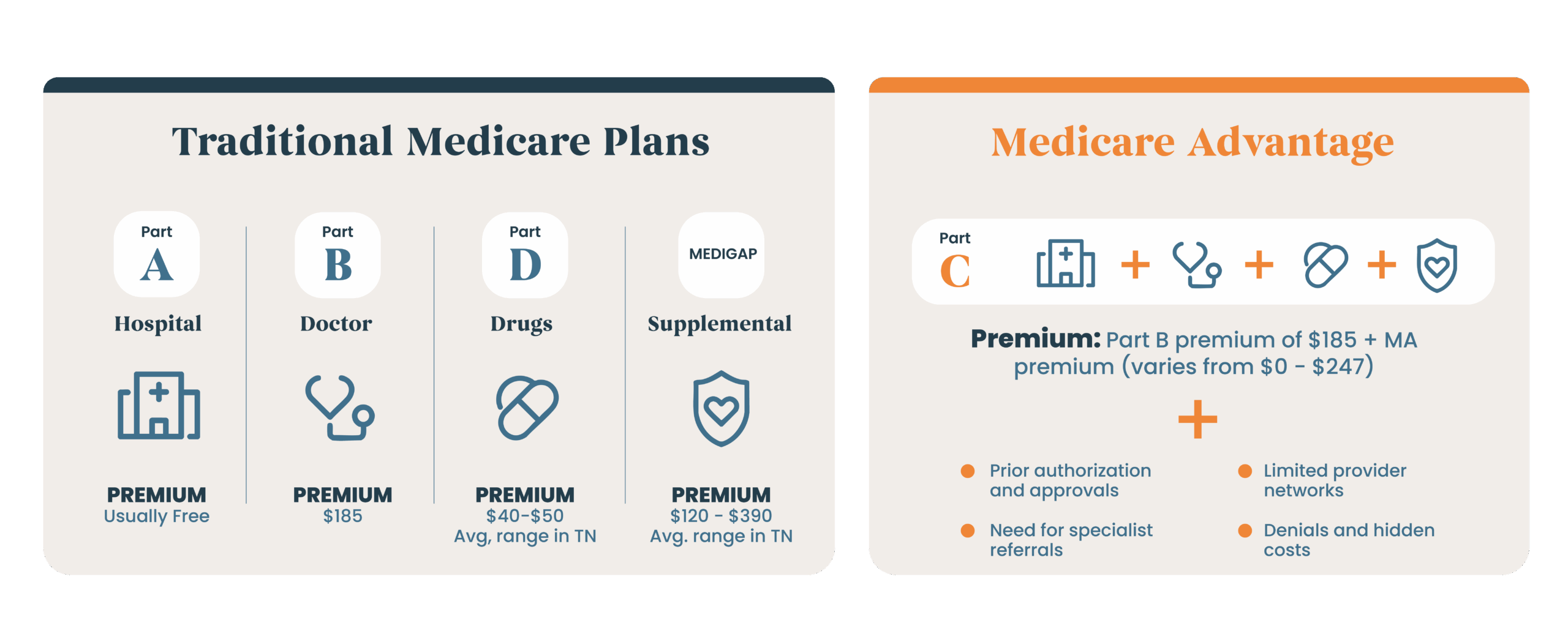
Traditional Medicare Plans in Detail
Traditional — Part A
- Covers hospital care
- Covers 80% of the cost for most medical bills
- Can use any hospital that takes Medicare, anywhere in the U.S
- Can add on additional coverage o help with unexpected costs
- Can add drug coverage
Premium: Usually Free
Traditional — Part B
- Covers doctor’s care
- Covers 80% of the cost for most medical bills
- Can use any doctor that takes Medicare, anywhere in the U.S
- Can add on additional coverage o help with unexpected costs
- Can add drug coverage
Premium: $185
Traditional — Part D
- Optional plan that adds drug coverage to Traditional Medicare
Premium: Average range in TN is $40-50
Traditional — MediGap
- Supplemental optional plan that helps pay your out-of-pocket costs that Part A and B don’t cover – like your 20% coinsurance
Your benefits won’t change, and as long as you pay premiums you keep your coverage
Premium: Average range in TN is $120 – $390
Medicare Advantage in Detail
Medicare Advantage — Part C
- Bundles hospital care, doctor’s office care, supplemental coverage and drug coverage into one plan
- Benefits are provided by a commercial insurance company
- You are restricted to using only the doctors and hospitals in your plan’s network
- You may need to get approval (prior authorization) from your plan before it covers certain types of care
- Plans may offer some extra benefits that Traditional Medicare doesn’t
- May not cover your care if you are away from your hometown area
Premium: Part B premium of $185 + MA premium (varies from $0 – $247)
Medicare Advantage Hidden Costs
- Out-of-Network Charges
If you see a doctor or go to a hospital outside your plan’s network (except in emergencies), you may pay much more—or even the full cost—for care.
- Prior Authorization Delays or Denials
Prior authorizations can lead to delays in care or denied coverage, shifting unexpected costs back to you.
- Higher Out-of-Pocket Costs for Complex Care
Medicare Advantage plans often have copays and coinsurance for each service which can add up quickly if you have an illness, injury, or chronic condition.
- Missed Medigap Opportunity
If you later switch from Medicare Advantage to Traditional Medicare, you may not be able to buy a Medigap plan—or it could cost more—due to medical underwriting.
- Limited Access to Specialized Care
Some top specialists, hospitals, or academic medical centers may not accept Medicare Advantage plans, meaning you’d pay full price for out-of-network care or be forced to switch doctors.
- Annual Changes to Coverage
Benefits, provider networks, and out-of-pocket costs can change every year, requiring you to carefully review your plan annually to avoid surprises.
Medicare Advantage plans may seem like a simpler, lower-cost alternative to Traditional Medicare. However, simplicity and lower monthly premiums typically come with tradeoffs:
- Tedious prior authorization processes
- Need for specialist referrals
- Limited provider networks
- Higher overall costs due to care denials and hidden costs.
The Bottom Line
Traditional Medicare + Medigap is best if you:
- Want more predictable healthcare costs.
- Prefer the freedom to get care from the doctors and hospitals you want.
- Prefer to pay more in monthly premiums in order to avoid commercial health insurance red tape that can cause care delays and denials.
Medicare Advantage is best if you:
- Want to save on monthly premiums and are prepared to pay more out-of-pocket if serious health issues arise.
- Prefer to have all of your healthcare coverage bundled into one plan and want “bonus” benefits like a gym membership or wellness program.
- Are comfortable with limited provider networks and the need for prior approvals and referrals for most services.


